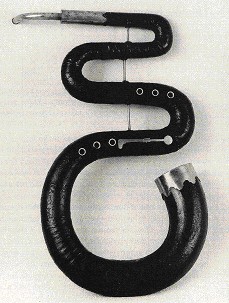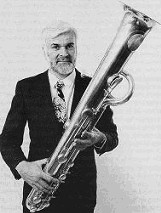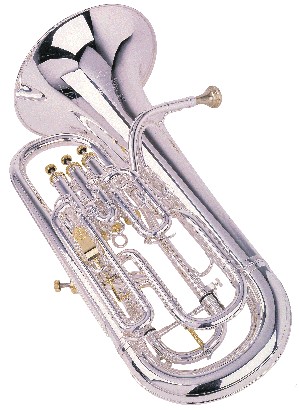The earliest forerunner of the euphonium as the tenor voice of the lip and reed family is generally thought to have been the serpent, deriving its name from its snake-like appearance. It was constructed of wood, brass, or silver and played with a deep-cup mouthpiece made of horn or ivory. The serpent is cited as a forerunner of the euphonium because they have several aspects in common. They both produce a sound the same way using a deep-cupped mouthpiece and both instruments are conical in bore and similar in length. Thus their tone colour and tessitura are similar.
 The serpent is the bass member of the cornett family. It usually has six finger holes to change pitch and was used most often as a supporting voice for the tenor and bass in church choirs and military bands. The rich sound of the Serpent was ideal for supporting the bass line in wind ensembles of the classical period and was in use for over three hundred years
The serpent is the bass member of the cornett family. It usually has six finger holes to change pitch and was used most often as a supporting voice for the tenor and bass in church choirs and military bands. The rich sound of the Serpent was ideal for supporting the bass line in wind ensembles of the classical period and was in use for over three hundred years
Some significant composers used serpents in their works. Handel wrote for it in Music for the Royal Fireworks (1749), Beethoven scored for the serpent in Military March (1816) and Wagner also wrote for it in Rienzi (1842). However it is well documented that the serpent was a very difficult instrument to play, largely because the finger holes are so widely spaced. Charles Burney, a nineteenth century music historian likened the sound of the serpent to that of a 'hungry or rather angry essex calf'! Few serpents were made after 1835, they eventually gave way to the more refined ophicleide.
The ophicleide was first introduced in 1817 by instrument maker, Jean Hilaire Aste. It was listed as the lowest member of a patented group of keyed bugles. It was made of brass and shaped somewhat like a saxophone. Like the serpent and the euphonium it was played with a cupped mouthpiece and produced a deep tone. Mendelssohn wrote for the ophicleide in his Midsummer Night's Dream as did Berlioz in his Symphony Fantastique.
Unlike the serpent, the ophicleide developed into a solo instrument. Several musicians became famous ophicleide soloists, the most eminent of these were Sam Hughes, Jean Prospere Guivier and Alfred Phasey, the former two reaching celebrity status with Jullien's Orchestra. The ophicleide was a difficult instrument to master. George Bernard Shaw referred to the sound of the ophicleide as, 'a chromatic bullock' but singled out Sam Hughes' rendition of 'Oh Ruddier than the Cherry' at Covent Garden as moving. The ophicleide would, however, soon be consumed by the advances of technology through the invention of the piston valve and the rapid growth of the brass band movement in Britain.
 Tom Winthorpe, (Royal Opera House Covent Garden,) with an ophicleide in C by Courtois played by Samuel Hughes with the Royal Italian Opera in the same theatre, c. 1870.
Tom Winthorpe, (Royal Opera House Covent Garden,) with an ophicleide in C by Courtois played by Samuel Hughes with the Royal Italian Opera in the same theatre, c. 1870.
The first piston valve was collaboratively patented in 1815 by Heinrich Stolzel and Friedrich Blumel. In 1823 William Wieprecht made a piston valved instrument called a Tenorbasshorn and in 1838 Carl Moritz of Berlin made a similar instrument called a tenor tuba. However, it was in 1843 that Sommer of Weimar designed and named a piston valved, tenor voiced instrument called a "euphonion". Its name is derived from the Greek word euphonos, meaning "sweet-voiced" and many consider this instrument to be the ancestor of the modern day euphonium.
The euphonium and the ophicleide co-existed for at least five decades, but the euphonium was easier to play, and both cheaper and easier to manufacture in large quantities. Interestingly, of the three aforementioned ophicleidists; Hughes, Prospere and Phasey, the latter learned the euphonium and earned a good living for himself. Sam Hughes ignored the euphonium, and died in 1898 leaving his widow in grief and poverty.
During the industrial revolution manufacturing techniques and production skills improved. The piston valve was a product of the revolution as were many other musical inventions. However, the most significant development relating to the emergence of the euphonium was the amateur brass band movement. Algernon Rose was informed that there were 40,000 brass bands in Britain by 1893 and in Herbert's and Myers' book, 'The British Brass Band', Arnold Myers states that brass band instrumentation had crystallized around the same period. This would mean that in the 50 or 60 years since Sommer invented the euphonium there were approximately 60,000 amateur euphoniumists in Britain.
The meteoric popularity of the instrument can not be attributed solely to the Industrial Revolution or the formation of the brass band movement. Instrument manufacturers actively promoted the euphonium by offering them as prizes to the best ophicleidists at competitions. This divisive practice contributed to the demise of the Ophicleide.
Adolph Sax produced a family of valved brass instruments called Saxhorns in the 1840's, which also contributed to the demise of the ophicleide and indeed the rise of the euphonium. Sax's Bb Baritone saxhorn and the Bb Bass saxhorn corresponded to the size and pitch of the euphonium and were among many of Sax's instruments promoted by the virtuosi Distin family.
It is worth emphasizing at this point that the serpent, ophicleide and euphonium as they appeared did not literally replace each other; all three co-existed for a long period before the euphonium finally replaced them. Similarly, it would be wrong to give the impression that the invention of the piston valve was entirely responsible for the growth of the brass band movement. In fact, Halliday's keyed bugles co-existed in brass bands for a number of years before piston valved instruments finally replaced them. However it is fair to say that the valve principle could be applied more easily to any voice of instrument. This was the main advantage it had over the keyed system.
Whilst the euphonium was flourishing in the brass band movement in Britain it was also becoming established in military bands throughout Europe and the USA. In 1850 French infantry and cavalry bands were required to have at least four bass saxhorns and two baritone horns. In 1851 The Royal Artillery Staff Band of Woolwich replaced their ophicleide with a euphonium and in 1870 Japan formed a military band utilizing two euphoniums. This trend of including euphoniums in the military band continued until the euphonium occupied a permanent position in military bands Worldwide. Richard Franko Goldman, son of the famous American concert band conductor, Edwin Franko Goldman said, "the euphonium is indispensable in wind bands".
Even today the euphonium nomenclature is, not entirely standardized. Spain's euphonium look-alike is called a 'bombadino', the Germans have a 'kleine bass' or 'baryton', Italy a 'flicoino basso' and France a 'Saxhorn-basse' or 'clarion-basse'. All of these are names for approximately the same valved bugle pitched in Bb with eight feet of conical tubing and the same basic range.
The design and development of the euphonium benefited from the technological advances of the industrial revolution. Early virtuoso players also contributed to the instrument's development. Alfred Phasey, professor of euphonium at the Military School of Music, Kneller Hall, increased the size of the instrument's bore twice, in 1859 and 1870. The designing of the first short valve action euphonium in 1864, is also attributed to him. This was done by making the port holes in the valves oval instead of round Despite these developments the instrument still had inherent problems of intonation, especially in the lower register. Some manufacturers overcame the problem by adding extra valves; some euphoniums had five and six valves. Other manufacturers designed instruments with accessible main tuning slides so the players could pull or push when required. None of these methods were totally successful.
In 1874 Dr David Blaikley, of Boosey and Co. London devised an automatic compensating system which dramatically improved the euphonium's intonation. He patented the invention and describes how it works below:
'The tubing connected to the third valve is passed through the first and second, in such a way that, when the third piston is depressed, air passes through passages in the first and second valves, besides the two passages ordinarily designed in the third. Additional tubing is connected with the first and second pistons respectively, to add two air passages to each of their valves. When the first or second piston is depressed with the third, the length of the passage is increased. When all three are simultaneously depressed, the whole of the additional tubing is employed, compensating for the lowering of the pitch of the instrument which is caused by depressing the third valve.'
When the patent ceased in 1974 the system was copied by most leading euphonium manufacturers including: Yamaha, Miraphone, Wilson, Hirsbrunner and Sterling. This advance allowed players even more easily than before to develop their technique and virtuosity.
A further development took place in 1964 when the brass band movement changed from high-pitch (A=452.5 vibrations per second) to low-pitch (A = 440 vibrations per second). This was an important development in terms of the euphonium becoming a recital instrument and it allowed it to experiment more accurately with alternative ensembles to the brass band.
In the mid seventies John Fletcher, world-renowned tubist helped Boosey and Hawkes Musical Instruments develop a new large bore, large bell Besson Sovereign. Many of the amateur euphoniumists in the brass band movement found this instrument too big to handle. In 1987 Boosey and Hawkes reintroduced the medium bore in addition to Fletcher's design. The two models were numbered Sovereign 968 and 967 respectively. Another significant change on these instruments was that the bells were manufactured in one piece, spun and formed on a mandrel rather than being gusseted and seamed. This allowed the bell to be made from thinner material.
In 2002 Boosey and Hawkes launched its Prestige Euphonium in two sizes as before (2052 & 2051). Euphonium soloist Steven Mead was largely responsible for the development of this instrument, which is now one of the most popular professional models throughout the world. The Prestige greatly improved the potential of the instrument to be played in-tune with the addition of a main tuning slide trigger. Further technological developments are inevitable in years to come, but for the first time since its invention, we now have a euphonium of near perfection.
 In 1891 a journalist from the Daily Telegraph suggested the sound of the euphonium was, "enough to make a Quaker kick his mother-in-law" and likened the instrument to a "fog-horn". Yet in 2004 a journalist from the Times suggested that the euphonium was "as flexible and agile as the trumpet" capable of producing a "superbly focused glowing tone". The euphonium has obviously come a long way and with continued dedication from the young euphonium players of today coupled with the continued development of repertoire, I believe the euphonium's future could be very bright.
In 1891 a journalist from the Daily Telegraph suggested the sound of the euphonium was, "enough to make a Quaker kick his mother-in-law" and likened the instrument to a "fog-horn". Yet in 2004 a journalist from the Times suggested that the euphonium was "as flexible and agile as the trumpet" capable of producing a "superbly focused glowing tone". The euphonium has obviously come a long way and with continued dedication from the young euphonium players of today coupled with the continued development of repertoire, I believe the euphonium's future could be very bright.




